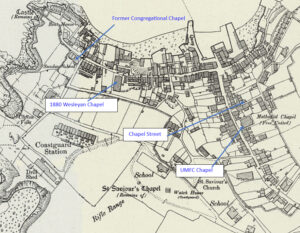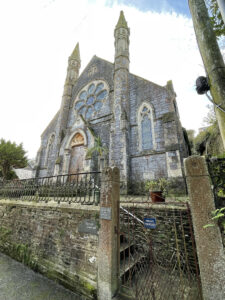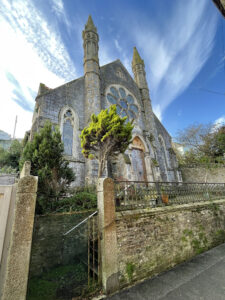
The Polruan Methodist Chapels have been profiled by Jo Lewis and Tony Mansell
Congregational / Wesleyan Chapel / Sunday School
Congregational Nonconformist Chapel (Post Medieval). Wesleyan Chapel, now converted to a house and altered. Killas rubble with granite dressings. (Heritage Gateway)
The Congregational chapel, Sunday school on map, sat at the end of West Street, beyond Battery Lane, south of the site of the castle.
Unknown build date.
Built as a Congregational Chapel.
1843: Wedding in Polruan Wesleyan Chapel. (Penzance Gazette – Wednesday 04 January 1843)
It is noted that the Registered Wesleyan Methodist places of worship in Cornwall, 1867 includes Polruan, so there may have been a previous chapel (or was this the Congregational?)
Unknown date: Wesleyans using it as a chapel. Possibly pre-1867 – see previous entry.
1882 map shows it as a Sunday school.
1908: The Chapel is no longer marked as such on maps and by this time the Wesleyan Sunday school may have moved into the 1888 Wesleyan Chapel.
1880 Wesleyan Chapel
 (Photo: Tony Mansell)
(Photo: Tony Mansell)
 (Photo: Tony Mansell)
(Photo: Tony Mansell)
Wesleyan Chapel, now Methodist Chapel, 1880 foundation stone. Designed by Mr Hicks of Redruth. Snecked grey limestone blocks with ashlar quoins and freestone dressings. Symmetrical gabled south front with slate roof. Free Gothic style. Gabled south front (ritual west) with central entrance in coped gabled stone porch with corner buttresses. Pitch pine diagonal boarded 3 panel double doors flanked by pilasters supporting 2 centred arch with foiled tracery in tympanum. Flanked by 2 engaged pinnacled octagonal turrets rising from tall square bases and
rising above gable apex with engaged shafts near top with blind arcading above surmounted by pinnacles which were once possibly decorated with finials. Flanked on ground floor by 2 lancet windows with foiled tracery within. Large central rose window above porch. Angle buttresses on corners. Cast iron railings Complete interior with raked seating with pitch pine benches. Pitch pine rostrum and rails. Dado panelling. Plastered ceiling is hammer beam in profile. (British Listed Buildings)
Nonconformist Chapel (19th Century to Unknown – 1880 AD) Coursed dressed granite with freestone dressings, steep dry slate roof. Italianate Gothic style by James Hicks. The 3-bay buttressed front has large rose window over gabled porch with traceried doorway; flanking octagonal buttresses surmounted by pinnacles on blind colonnades; single-light windows with traceried heads to side bays. Low dressed granite forecourt walls with ornate iron railings. (Heritage Gateway)
Built either as an additional chapel or to replace the congregational chapel. This striking stone building is grade 2 listed and can be seen from the sea. Foundation stone was laid in 1880 and it was designed by Mr Hicks of Redruth. The Wesleyan chapel is a building of limestone, with Bath stone dressings, in the Decorated style at a cost of £1,220, and will seat 320 persons (1902 Kelly’s)
1880s: Build date.
1880: Laying memorial-stones of a new Wesleyan chapel Polruan. (Illustrated London News – Saturday 25 September 1880 / Western Daily Mercury – Friday 17 September 1880)
Built as a Wesleyan Chapel. (SWChurches)
Seating: 330. (David Easton, Methodist Historian)
1881: Opening of the New Wesleyan Chapel at Polruan. The New Wesleyan Chapel, Polruan, the foundation stones of which were laid in September, was opened yesterday (Thursday) week… The building is an exceedingly pretty little structure, elevated some seven cr fight feet above the public road, and is approached by flights of steps on either side. The front consists of a large gable, having a porch in the centre, facing the road, and a centre rose window, about twelve feet in diameter, flanked by lofty turrets, and two smaller gables constructed of Plymouth limestone, with bath stone dressings, the whole forming a picturesque group of more than ordinary architectural beauty. The chapel is 50 feet long by 39 feet wide. Thia includes vestries at the rear, and an organ chamber over the vestries, opening into the chapel by a bold Gothic archway. The building is not constructed for galleries. The pews, which are with the other joinery, of pitch pine, will seat about 300 people. The ceiling of the chapel is plastered, arched in three curves – the centre arch rising to a height of 29 feet above the floor The windows are glazed with Cathedral glass. The rose windows in the orchestra and front consist of ornamental glazing. The builders were Messrs Crossentine and the architect, Mr J. Hicks, Redruth; Mr Penter doing the masonry. The chapel has cost £1,200 …” (Royal Cornwall Gazette – Friday 29 July 1881)
1881: Furter report of opening. (The Cornish Telegraph – Thursday 28 July 1881)
1881: Reference to the new Polruan Chapel. (West Briton and Cornwall Advertiser – Thursday 28 July 1881)
1907: The Methodist New Connexion, Bible Christians and United Methodist Free Churches amalgamated to become the United Methodist Church.
1932: The Wesleyan, Primitive Methodist and the United Methodist Church amalgamated to become the Methodist Church of Great Britain.
1932: Became West Street Methodist Chapel. (SWChurches)
1958: The congregation of the former UMFC in Fore Street merged with the congregation here when their chapel closed.
1995: West Street Methodist Chapel closed. (David Easton, Methodist Historian)
